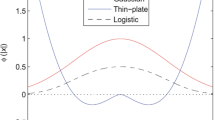Abstract
This paper introduces a novel hybrid algorithm to determine the parameters of radial basis function neural networks (number of neurons, centers, width and weights) automatically. The hybrid algorithm combines the mix encoding particle swarm optimization algorithm with the back propagation (BP) algorithm to form a hybrid learning algorithm (MPSO-BP) for training Radial Basis Function Networks (RBFNs), which adapts to the network structure and updates its weights by choosing a special fitness function. The proposed method is used to deal with three nonlinear problems, and the results obtained are compared with existent bibliography, showing an improvement over the published methods.






Similar content being viewed by others
References
Shahsavand A, Ahmadpour A (2005) Application of optimal RBF neural networks for optimization and characterization of porous materials. Comput Chem Eng 29(10):2134–2143. doi:10.1016/j.compchemeng.2005.07.002
Park J, Sandberg IW (1991) Universal approximation using radial basis functions network. Neural Comput 3(1):246–257. doi:10.1162/neco.1991.3.2.246
Mu T, Asoke K Nandi, RBF neural networks for solving the inverse problem of backscattering spectra. Neural Comput Appl. doi:10.1007/s00521-007-0138-2
Zhang A, Zhang L (2004) RBF neural networks for the prediction of building interference effects. Comput Struc 82:2333–2339. doi:10.1016/j.compstruc.2004.05.014
Ram D, Srivastava L, Pandit M, Sharma J (2007) Corrective action planning using RBF neural network. Appl Soft Comput 7(3):1055–1063. doi:10.1016/j.asoc.2006.10.007
Darken C, Moody J (1990) Fast adaptive K-means clustering: some empirical results. Proceedings of IEEE INNS international joint conference on neural networks, pp 233–238
Chinrungrueng C, Sequin CH (1995) Optimal adaptive k-means algorithm with dynamic adjustment of learning rate. IEEE Trans Neural Netw 6(3):157–168. doi:10.1109/72.363440
Haykin S (1994) Neural networks—a comprehensive foundation. IEEE Press, New York
Chen S, Cowan CFN, Grant PM (1991) Orthogonal least squares learning algorithm for radial basis function networks. IEEE Trans Neural Netw 2(3):302–309. doi:10.1109/72.80341
Sherstinsky A, Picard RW (1996) On the efficiency of the orthogonal least squares training method for radial basis function networks. IEEE Trans Neural Netw 7(1):195–200. doi:10.1109/72.478404
Hassibi B, Stork DG (1993) Second order derivatives for network pruning: optimal brain surgeon. In: Hanson SJ et al (eds) NIPS, vol 5. Morgan Kaufmann, Los Altos, pp 164–172
Leonardis A, Bischof H (1998) An efficient MDL-based construction of RBF networks. Neural Netw 11(5):963–973. doi:10.1016/S0893-6080(98)00051-3
Huang GB, Saratchandran P, Sundararajan N (2004) An efficient sequential learning algorithm for growing and pruning RBF (GAP-RBF) networks. IEEE Trans Syst Man Cybern 34(6):2284–2292. doi:10.1109/TSMCB.2004.834428
Zhang R, Huang G, Saratchandran P, Sundararajan N (2006) Improved GAP-RBF network for classification problems. Neurocomputing. doi: 10.1016/j.neucom.2006.07.016
Alexandridis A, Sarimveis H, Bafas G (2003) A new algorithm for online structure and parameter adaptation of RBF networks. Neural Netw 16(7):1003–1017. doi:10.1016/S0893-6080(03)00052-2
Staianoa A, Tagliaferria R, Pedryczb W (2006) Improving RBF networks performance in regression tasks by means of a supervised fuzzy clustering. Neurocomputing 69(13–15):1570–1581. doi:10.1016/j.neucom.2005.06.014
Fritzke B (1994) Fast learning with incremental RBF networks. Neural Process Lett 1(1):2–5. doi:10.1007/BF02312392
Zhu Q, Cai Y, Liu L (1996) A global learning algorithm for a RBF network. Neural Netw 12(3):527–540. doi:10.1016/S0893-6080(98)00146-4
Billings SA, Zheng GL (1995) Radial basis function network configuration using genetic algorithms. Neural Netw 8(6):877–890. doi:10.1016/0893-6080(95)00029-Y
Kennedy J, Eberhart R, Shi YH (2001) Swarm intelligence. Morgan Kaufmann, San Francisco
Liu W, Wang K (2007) Predicting chaotic time series using hybrid particle swarm optimization algorithm. Contr Decis 22(5):562–565
Li XB, Liu D, Zuo L (2007) Application of RBF-PSO in nonlinear calibration for thermocouple sensor. Chin J Sens Actuators 20(4):933–936
Feng HM (2006) Self-generation RBFNs using evolutional PSO learning. Neurocomputing 70(1–3):241–251. doi:10.1016/j.neucom.2006.03.007
Cover TM (1965) Geometrical and statistical properties of systems of linear inequalities with application in pattern recognition. IEEE Trans Electron Comput EC 14(2):326–334. doi:10.1109/PGEC.1965.264136
Broomhead DS, Lowe D (1988) Multivariable functional interpolation and adaptive networks. Complex Syst 2:321–355
Karayiannis NB (1999) Reformulated radial basis neural networks trained by gradient descent. IEEE Trans Neural Netw 10(3):657–671. doi:10.1109/72.761725
Moody J, Darken C (1989) Faster learning in networks of locally tuned processing units. Neural Comput 1(3):281–294. doi:10.1162/neco.1989.1.2.281
Haykin S (1999) Neural networks: a comprehensive foundation, 2nd edn. Prentice Hall, New Jersey
Eberhart R, Kennedy J (1995) Particle swarm optimization. IEEE Int Conf Neural Netw IV:1942–1947
Clerc M (1999) The swarm and the queen: towards a deterministic and adaptive particle swarm optimization. In: Proceeding congress on evolutionary computation, Washington DC, pp 1951–1957
Shi YH, Eberhart R (1998) A modified particle swarm optimizer. In: IEEE international conference on evolutionary computation, pp 69–73
Kennedy J, Eberhart R (1997) A discrete binary version of the particle swarm algorithm. In: Proceedings of the World multiconference on systemic, cybernetics and informatics, Piscataway, NJ, pp 4104–4109
Wong CC, Chen CC (1999) A hybrid clustering and gradient descent approach for fuzzy modeling. IEEE Trans Syst Man Cybern 29(6):686–693
Narendra KS, Parthasarathy K (1990) Identification and control of dynamical systems using neural networks. IEEE Trans Neural Netw 1(2):4–27. doi:10.1109/72.80202
Liu GP, Kadirkamanathan V, Billings SA (1998) Online identification of nonlinear systems using Volterra polynomial basis function neural networks. Neural Netw 11(9):1645–1657. doi:10.1016/S0893-6080(98)00100-2
Machine Learning Repository UCI. http://www.ics.uci.edu/_mlearn/MLRepository.html
Acknowledgments
This research was fully supported by National Natural Science Foundation Grant No. 70573101 of the People’s Republic of China.
Author information
Authors and Affiliations
Corresponding author
Rights and permissions
About this article
Cite this article
Yu, S., Zhu, K. & Gao, S. A hybrid MPSO-BP structure adaptive algorithm for RBFNs. Neural Comput & Applic 18, 769–779 (2009). https://doi.org/10.1007/s00521-008-0214-2
Received:
Accepted:
Published:
Issue Date:
DOI: https://doi.org/10.1007/s00521-008-0214-2




